2000 HONDA CIVIC COUPE brake
[x] Cancel search: brakePage 172 of 293
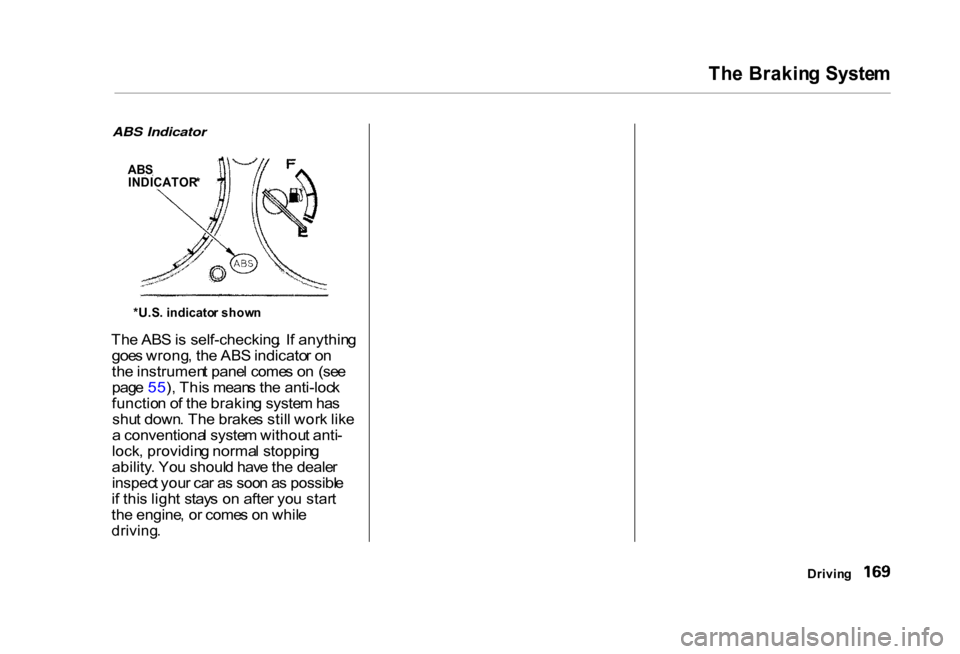
Th
e Brakin g Syste m
Drivin g
ABS Indicator
Th e AB S is self-checking . I f anythin g
goe s wrong , th e AB S indicato r o n
th e instrumen t pane l come s o n (se e
pag e 55 ), Thi s mean s th e anti-loc k
functio n o f th e brakin g syste m ha s
shu t down . Th e brake s stil l wor k lik e
a conventiona l syste m withou t anti -
lock , providin g norma l stoppin g
ability . Yo u shoul d hav e th e deale r
inspec t you r ca r a s soo n a s possibl e
i f thi s ligh t stay s o n afte r yo u star t
th e engine , o r come s o n whil e
driving .
AB
S
INDICATOR *
*U.S . indicato r show n
Page 173 of 293

Drivin
g in Ba d Weathe r
Rain , fog , an d sno w condition s re -
quir e a differen t drivin g techniqu e
becaus e o f reduce d tractio n an d
visibility . Kee p you r ca r well -
maintaine d an d exercis e greate r
cautio n whe n yo u nee d to driv e in
ba d weather . Th e cruis e contro l
shoul d no t b e use d in thes e condi -
tions .
Drivin
g Techniqu e — Alway s driv e
slowe r tha n yo u woul d in dr y
weather . I t take s you r ca r longe r t o
react , eve n in condition s tha t ma y
see m jus t barel y damp . Appl y
smooth , eve n pressur e to al l th e
controls . Abrup t steerin g whee l
movement s o r sudden , har d appli -
catio n o f th e brake s ca n caus e los s o f
contro l i n we t weather . B e extr a
cautiou s fo r th e firs t fe w mile s
(kilometers ) o f drivin g whil e yo u
adjus t t o th e chang e in drivin g
conditions . Thi s i s especiall y tru e in
snow . A perso n ca n forge t som e
snow-drivin g technique s durin g th e
summe r months . Practic e is neede d
t o relear n thos e skills .
Exercis e extr a cautio n whe n drivin g
i n rai n afte r a lon g dr y spell . Afte r
month s o f dr y weather , th e firs t
rain s brin g oi l t o th e surfac e o f th e
roadway , makin g it slippery . Visibilit
y — Bein g abl e to se e
clearl y in al l direction s an d bein g
visibl e to othe r driver s ar e importan t
i n al l weathe r conditions . Thi s is
mor e difficul t i n ba d weather . T o b e
see n mor e clearl y durin g dayligh t
hours , tur n o n you r headlights .
Inspec t you r windshiel d wiper s an d
washer s frequently . Kee p th e wind -
shiel d washe r reservoi r ful l o f th e
prope r fluid . Hav e th e windshiel d
wipe r blade s replace d if the y star t t o
strea k th e windshiel d o r leav e part s
unwiped . Us e th e defroster s an d ai r
conditionin g to kee p th e window s
fro m foggin g u p o n th e insid e (se e
pag e 9 5 ) .
Drivin g
Page 179 of 293
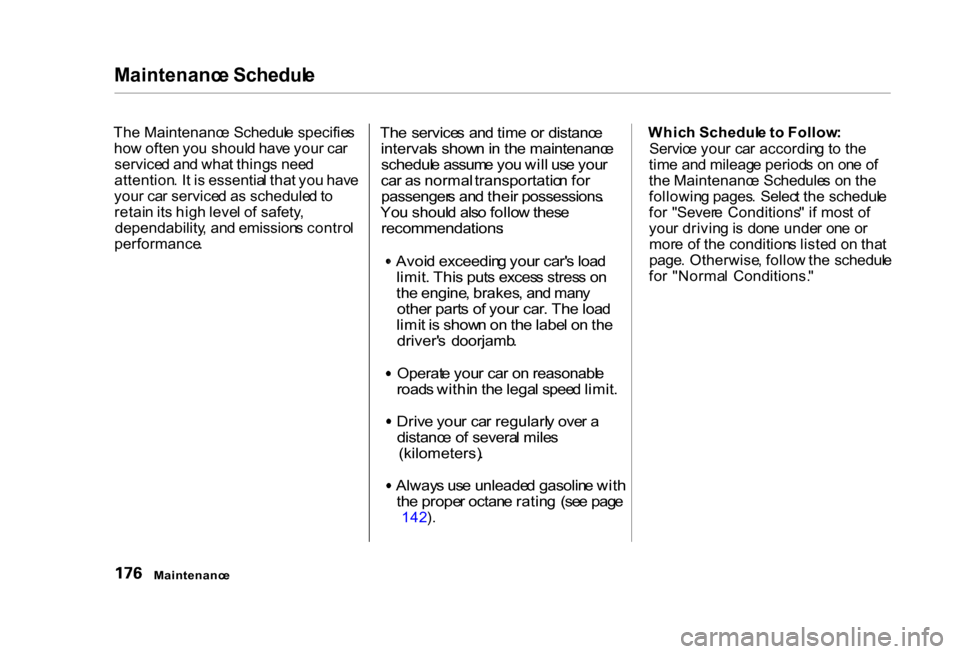
Maintenanc
e Schedul e
Th e Maintenanc e Schedul e specifie s
ho w ofte n yo u shoul d hav e you r ca r
service d an d wha t thing s nee d
attention . I t i s essentia l tha t yo u hav e
you r ca r service d a s schedule d to
retai n it s hig h leve l o f safety ,
dependability , an d emission s contro l
performance .
Th
e service s an d tim e o r distanc e
interval s show n in th e maintenanc e
schedul e assum e yo u wil l us e you r
ca r a s normal transportatio n fo r
passenger s an d thei r possessions .
Yo u shoul d als o follo w thes e
recommendations :
Avoi d exceedin g you r car' s loa d
limit . Thi s put s exces s stres s o n
th e engine , brakes , an d man y
othe r part s o f you r car . Th e loa d
limi t i s show n o n th e labe l o n th e
driver' s doorjamb .
Operat e you r ca r o n reasonabl e
road s withi n th e lega l spee d limit .
Driv e you r ca r regularl y ove r a
distanc e o f severa l mile s
(kilometers) . Alway
s us e unleade d gasolin e wit h
th e prope r octan e ratin g (se e pag e
142 ). Whic
h Schedul e t o Follow :
Servic e you r ca r accordin g t o th e
tim e an d mileag e period s o n on e o f
th e Maintenanc e Schedule s o n th e
followin g pages . Selec t th e schedul e
fo r "Sever e Conditions " i f mos t o f
you r drivin g is don e unde r on e o r
mor e o f th e condition s liste d o n tha t
page . Otherwise , follo w th e schedul e
fo r "Norma l Conditions. "
Maintenanc e
Page 188 of 293
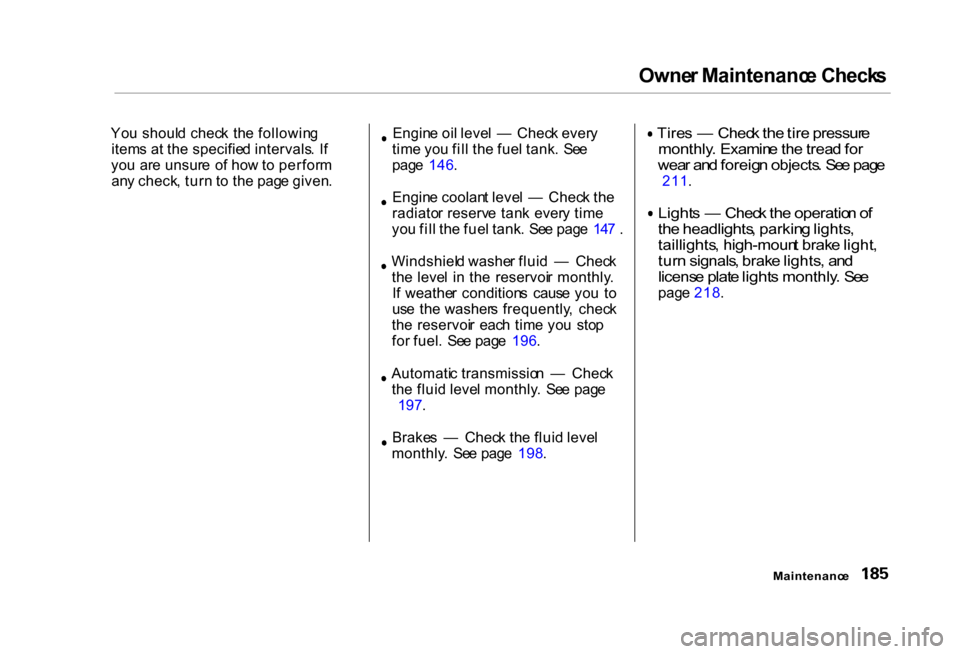
Owne
r Maintenanc e Check s
Yo u shoul d chec k th e followin g
item s a t th e specifie d intervals . I f
yo u ar e unsur e o f ho w to perfor m
an y check , tur n t o th e pag e given . Engin
e oi l leve l — Chec k ever y
tim e yo u fil l th e fue l tank . Se e
pag e 146 .
Engin e coolan t leve l — Chec k th e
radiato r reserv e tan k ever y tim e
yo u fil l th e fue l tank . Se e pag e 14 7 .
Windshiel d washe r flui d — Chec k
th e leve l i n th e reservoi r monthly .
I f weathe r condition s caus e yo u t o
us e th e washer s frequently , chec k
th e reservoi r eac h tim e yo u sto p
fo r fuel . Se e pag e 196 .
Automati c transmissio n — Chec k
th e flui d leve l monthly . Se e pag e
197 .
Brake s — Chec k th e flui d leve l monthly
. Se e pag e 198 .
Tire
s — Chec k th e tir e pressur e
monthly . Examin e th e trea d fo r
wea r an d foreig n objects . Se e pag e
211 .
Light
s — Chec k th e operatio n o f
th e headlights , parkin g lights ,
taillights , high-moun t brak e light ,
tur n signals , brak e lights , an d
licens e plat e light s monthly . Se e
pag e 218 .
Maintenanc e
Page 220 of 293

Tire
s
Tire Chains
Moun t sno w chain s o n you r vehicl e
whe n warrante d b y drivin g condi -
tion s o r require d b y loca l laws . Mak e
sur e th e chain s ar e th e correc t siz e
fo r you r tires . Instal l the m onl y o n
th e fron t tires . I f meta l chain s ar e
used , the y mus t b e SA E clas s "S. "
Cabl e typ e tractio n device s ca n als o
b e used .
Whe n installin g chains , follo w th e
manufacturer' s instruction s an d
moun t the m as tightl y a s yo u can .
Driv e slowl y wit h chain s installed . I f
yo u hea r th e chain s contactin g th e
bod y o r chassis , sto p an d investigate .
Mak e sur e th e chain s ar e installe d
tightly , an d tha t the y ar e no t
contactin g th e brak e line s o r
suspension . Remov e th e chain s a s
soo n a s yo u begi n drivin g o n cleare d
roads .
Chains of the wrong size or that are
improperly installed can damage your
car's brake lines, suspension, body, and
wheels. Stop driving if you hear the chains hitting any part of the car.
Maintenance
NOTIC
E
Page 242 of 293

Changin
g a Fla t Tir e
I f yo u hav e a fla t tir e whil e driving ,
sto p in a saf e plac e t o chang e it .
Stoppin g in traffi c o r o n th e shoulde r
o f a bus y roa d is dangerous . Driv e
slowl y alon g th e shoulde r unti l yo u
ge t t o a n exi t o r a n are a to sto p tha t
i s fa r awa y fro m th e traffi c lanes .
1. Par k th e ca r o n firm , leve l an d
non-slipper y groun d awa y fro m
traffic . Pu t th e transmissio n i n
Par k (automatic ) o r Revers e
(manual) . Appl y th e parkin g brake .
2 . Tur n o n th e hazar d warnin g light s
an d tur n th e ignitio n switc h t o
LOC K (0) . Hav e al l th e
passenger s ge t ou t o f th e ca r whil e
yo u chang e th e tire . 3
. Ope n th e trunk . Rais e th e trun k
floo r b y liftin g u p o n th e bac k edge .
4 . Tak e th e too l ki t ou t o f th e trunk .
5 . Unscre w th e win g bol t an d tak e
th e spar e tir e ou t o f it s well .
CONTINUED
Takin g Car e o f th e Unexpecte d
Th
e ca r ca n easil y rol l of f th e
jack , seriousl y injurin g anyon e
underneath .
Follo w th e direction s fo r
changin g a tir e exactly , an d
neve r ge t unde r th e ca r whe n i t
i s supporte d onl y b y th e jack . SPAR
E TIR E TRUN
K FLOO R
TOO L KI T JAC
K
Page 248 of 293
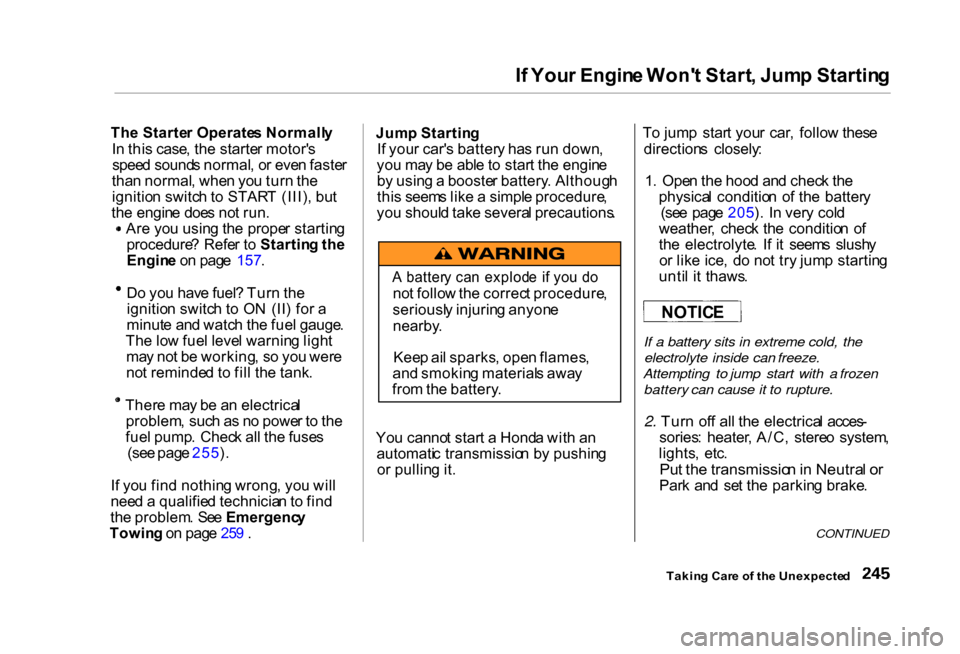
I
f You r Engin e Won' t Start , Jum p Startin g
Th e Starte r Operate s Normall y
I n thi s case , th e starte r motor' s
spee d sound s normal , o r eve n faste r
tha n normal , whe n yo u tur n th e
ignitio n switc h t o STAR T (III) , bu t
th e engin e doe s no t run . Ar
e yo u usin g th e prope r startin g
procedure ? Refe r t o Startin g th e
Engin e o n pag e 157 . D
o yo u hav e fuel ? Tur n th e
ignitio n switc h t o O N (II ) fo r a
minut e an d watc h th e fue l gauge .
Th e lo w fue l leve l warnin g ligh t
ma y no t b e working , s o yo u wer e
no t reminde d t o fil l th e tank . Ther
e ma y b e a n electrica l
problem , suc h a s n o powe r t o th e
fue l pump . Chec k al l th e fuse s
(se e pag e 255 ).
I f yo u fin d nothin g wrong , yo u wil l
nee d a qualifie d technicia n to fin d
th e problem . Se e Emergenc y
Towin g o n pag e 25 9 . Jum
p Startin g
I f you r car' s batter y ha s ru n down ,
yo u ma y b e abl e to star t th e engin e
b y usin g a booste r battery . Althoug h
thi s seem s lik e a simpl e procedure ,
yo u shoul d tak e severa l precautions .
Yo u canno t star t a Hond a wit h a n
automati c transmissio n b y pushin g
o r pullin g it . T
o jum p star t you r car , follo w thes e
direction s closely :
1 . Ope n th e hoo d an d chec k th e
physica l conditio n o f th e batter y
(se e pag e 205 ). I n ver y col d
weather , chec k th e conditio n o f
th e electrolyte . I f i t seem s slush y
o r lik e ice , d o no t tr y jum p startin g
unti l i t thaws .
If a battery sits in extreme cold, the
electrolyte inside can freeze.
Attempting to jump start with a frozen
battery can cause it to rupture.
2. Tur n of f al l th e electrica l acces -
sories : heater , A/C , stere o system ,
lights , etc .
Pu t th e transmissio n in Neutra l o r
Par k an d se t th e parkin g brake .
CONTINUED
Takin g Car e o f th e Unexpecte d
A
batter y ca n explod e i f yo u d o
no t follo w th e correc t procedure ,
seriousl y injurin g anyon e
nearby .
Kee p ai l sparks , ope n flames ,
an d smokin g material s awa y
fro m th e battery .
NOTIC
E
Page 250 of 293
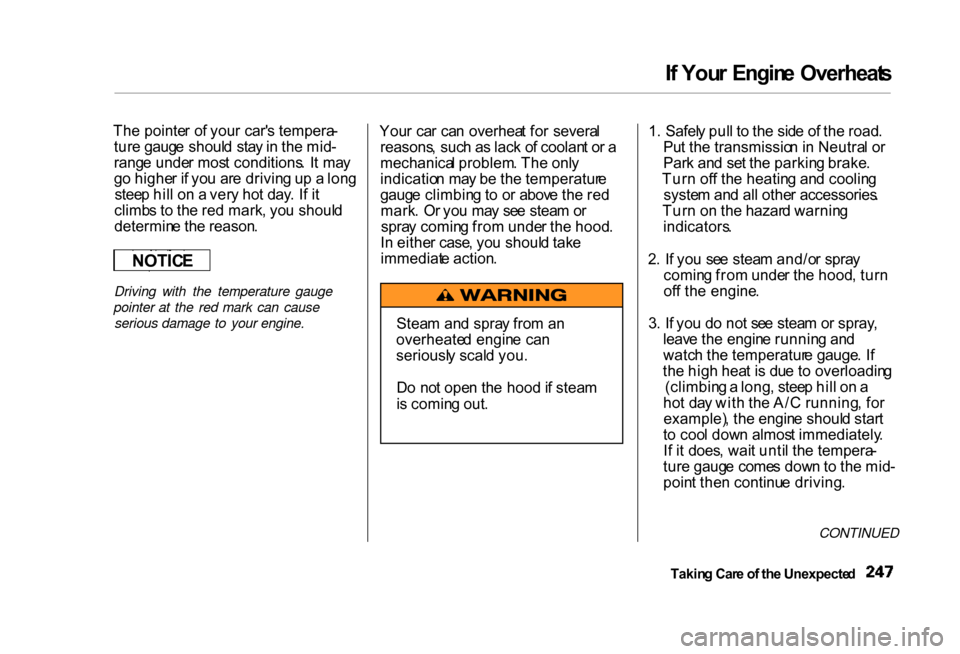
I
f You r Engin e Overheat s
Th e pointe r o f you r car' s tempera -
tur e gaug e shoul d sta y in th e mid -
rang e unde r mos t conditions . I t ma y
g o highe r i f yo u ar e drivin g u p a lon g
stee p hil l o n a ver y ho t day . I f i t
climb s t o th e re d mark , yo u shoul d
determin e th e reason .
Driving with the temperature gauge
pointer at the red mark can cause serious damage to your engine. You
r ca r ca n overhea t fo r severa l
reasons , suc h a s lac k o f coolan t o r a
mechanica l problem . Th e onl y
indicatio n ma y b e th e temperatur e
gaug e climbin g to o r abov e th e re d
mark . O r yo u ma y se e stea m o r
spra y comin g fro m unde r th e hood .
I n eithe r case , yo u shoul d tak e
immediat e action . 1
. Safel y pul l t o th e sid e o f th e road .
Pu t th e transmissio n in Neutra l o r
Par k an d se t th e parkin g brake .
Tur n of f th e heatin g an d coolin g
syste m an d al l othe r accessories .
Tur n o n th e hazar d warnin g
indicators .
2 . I f yo u se e stea m and/o r spra y
comin g fro m unde r th e hood , tur n
of f th e engine .
3 . I f yo u d o no t se e stea m o r spray ,
leav e th e engin e runnin g an d
watc h th e temperatur e gauge . I f
th e hig h hea t i s du e t o overloadin g
(climbin g a long , stee p hil l o n a
ho t da y wit h th e A/ C running , fo r
example) , th e engin e shoul d star t
t o coo l dow n almos t immediately .
I f i t does , wai t unti l th e tempera -
tur e gaug e come s dow n to th e mid -
poin t the n continu e driving .
CONTINUED
Takin g Car e o f th e Unexpecte d
Stea
m an d spra y fro m a n
overheate d engin e ca n
seriousl y scal d you .
D o no t ope n th e hood if stea m
i s comin g out .
NOTIC
E